Experimental Study on Hydroelectric Energy Harvester Based on a Hybrid Qiqi and Turbine Structure
Abstract
:1. Introduction
2. Overview of the Investigated Structure
3. Theoretical Investigation
3.1. Working Principle
3.2. Modelling
3.2.1. Modelling of the Hybrid Structure
3.2.2. Modelling of Energy Harvesting Applications Using the Hybrid Structure
4. Experimental Validation
5. Conclusions
Supplementary Materials
Author Contributions
Funding
Data Availability Statement
Conflicts of Interest
References
- Hosseinie, R.; Roohi, R.; Ahmadi, G. Modeling and analysis of a fully passive swinging sail wind turbine. Wind. Energy 2021, 24, 653–671. [Google Scholar] [CrossRef]
- Pustina, L.; Lugni, C.; Bernardini, G.; Serafini, J.; Gennaretti, M. Control of power generated by a floating offshore wind turbine perturbed by sea waves. Renew. Sustain. Energy Rev. 2020, 132, 109984. [Google Scholar] [CrossRef]
- Fang, S.; Wang, S.; Zhou, S.; Yang, Z.; Liao, W.H. Exploiting the advantages of the centrifugal softening effect in rotational impact energy harvesting. Appl. Phys. Lett. 2020, 116, 063903. [Google Scholar] [CrossRef]
- Fang, S.; Wang, S.; Zhou, S.; Yang, Z.; Liao, W.H. Analytical and experimental investigation of the centrifugal softening and stiffening effects in rotational energy harvesting. J. Sound Vib. 2020, 488, 115643. [Google Scholar] [CrossRef]
- Ma, P.; Liu, G.; Wang, H.; Wang, Y.; Xie, Y. Co-simulations of a semi-passive oscillating foil turbine using a hydraulic system. Energy 2021, 217, 119323. [Google Scholar] [CrossRef]
- Badhurshah, R.; Dudhgaonkar, P.; Jalihal, P.; Samad, A. High efficiency design of an impulse turbine used in oscillating water column to harvest wave energy. Renew. Energy 2018, 121, 344–354. [Google Scholar] [CrossRef]
- Bhattarai, S.; Vichare, P.; Dahal, K.; Al Makky, A.; Olabi, A. Novel trends in modelling techniques of Pelton Turbine bucket for increased renewable energy production. Renew. Sustain. Energy Rev. 2019, 112, 87–101. [Google Scholar] [CrossRef]
- Breeze, P. Chapter 8-Hydropower. In Power Generation Technologies, 2nd ed.; Breeze, P., Ed.; Newnes: Boston, MA, USA, 2014; pp. 153–179. Available online: https://www.sciencedirect.com/science/article/pii/B9780080983301000089 (accessed on 1 November 2021).
- Halder, P.; Doppalapudi, A.T.; Azad, A.K.; Khan, M.M. Efficient Hydroenergy Conversion Technologies, Challenges, and Policy Implication//Advances in Clean Energy Technologies; Academic Press: Cambridge, MA, USA, 2021; pp. 295–318. [Google Scholar]
- Hadi, F.; Yang, H.; Traum, M.J. Assessment of Performance of Tesla Turbine in Water Distribution Systems for Energy Harvesting. J. Energy Resour. Technol. 2020, 143, 1–17. [Google Scholar] [CrossRef]
- Mohammadi, M.; Maghrebi, M.J. Improvement of wind turbine aerodynamic performance by vanquishing stall with active multi air jet blowing. Energy 2021, 224, 120176. [Google Scholar] [CrossRef]
- Fan, X.; Wang, Z.; Wang, Y.; Tan, W. The effect of vortices structures on the flow-induced vibration of three flexible tandem cylinders. Int. J. Mech. Sci. 2021, 192, 106132. [Google Scholar] [CrossRef]
- Zamanian, M.; Garibaldi, L. Vortex induced vibration analysis of a cylinder mounted on a flexible rod. Wind Struct. 2019, 29, 441–455. [Google Scholar]
- Furquan, M.; Mittal, S. Multiple lock-ins in vortex-induced vibration of a filament. J. Fluid Mech. 2021, 916, 916. [Google Scholar] [CrossRef]
- Wang, J.; Sun, S.; Tang, L.; Hu, G.; Liang, J. On the use of meta-surface for Vortex-Induced vibration suppression or energy harvesting. Energy Convers. Manag. 2021, 235, 113991. [Google Scholar] [CrossRef]
- Wang, S.; Liao, W.; Zhang, Z.; Liao, Y.; Yan, M.; Kan, J. Development of a novel non-contact piezoelectric wind energy harvester excited by vortex-induced vibration. Energy Convers. Manag. 2021, 235, 113980. [Google Scholar] [CrossRef]
- Lai, Z.; Wang, S.; Zhu, L.; Zhang, G.; Wang, J.; Yang, K.; Yurchenko, D. A hybrid piezo-dielectric wind energy harvester for high-performance vortex-induced vibration energy harvesting. Mech. Syst. Signal Process. 2021, 150, 107212. [Google Scholar] [CrossRef]
- Yang, K.; Abdelkefi, A.; Li, X.; Mao, Y.; Dai, L.; Wang, J. Stochastic analysis of a galloping-random wind energy harvesting performance on a buoy platform. Energy Convers. Manag. 2021, 238, 114174. [Google Scholar] [CrossRef]
- Tosi, L.P.; Dorschner, B.; Colonius, T. Flutter instability in an internal flow energy harvester. J. Fluid Mech. 2021, 915, A40. [Google Scholar] [CrossRef]
- Wang, J.; Su, Z.; Li, H.; Ding, L.; Zhu, H.; Gaidai, O. Imposing a wake effect to improve clean marine energy harvesting by flow-induced vibrations. Ocean Eng. 2020, 208, 107455. [Google Scholar] [CrossRef]
- Wang, J.; Geng, L.; Ding, L.; Zhu, H.; Yurchenko, D. The state-of-the-art review on energy harvesting from flow-induced vibrations. Appl. Energy 2020, 267, 114902. [Google Scholar] [CrossRef]
- Hu, G.; Wang, J.; Tang, L. A comb-like beam based piezoelectric system for galloping energy harvesting. Mech. Syst. Signal Pr. 2021, 150, 107301. [Google Scholar] [CrossRef]
- Zaheri Abdehvand, M.; Seyed Roknizadeh, S.A.; Mohammad-Sedighi, H. Parametric study of a novel magneto-electro-aeroelastic energy harvesting system. Proc. Inst. Mech. Eng. Part L J. Mater. Des. Appl. 2021, 235, 2100–2111. [Google Scholar] [CrossRef]
- Wang, J.; Geng, L.; Zhang, M.; Zhao, G.; Zhang, M.; Zhang, Z.; Li, Y. Broadening band of wind speed for aeroelastic energy scavenging of a cylinder through buffeting in the wakes of a squared prism. Shock Vib. 2018, 2018, 2039561. [Google Scholar] [CrossRef]
- Bao, B.; Wang, Q. A rain energy harvester using a self-release tank. Mech. Syst. Signal Pr. 2021, 147, 107099. [Google Scholar] [CrossRef]
- Bao, B.; Wang, Q. Small-scale experimental study on the optimisation of a rooftop rainwater energy harvester using electromagnetic generators in light rains. Int. J. Energy Res. 2020, 44, 10778–10796. [Google Scholar] [CrossRef]
- Bao, B.; Wang, Q. Bladeless rotational piezoelectric energy harvester for hydroelectric applications of ultra-low and wide-range flow rates. Energy Convers. Manag. 2021, 227, 113619. [Google Scholar] [CrossRef]
- Available online: https://en.wikipedia.org/wiki/Taijitu (accessed on 1 November 2021).
- Akoun, G.; Yonnet, J.P. 3D analytical calculation of the forces exerted between two cuboidal magnets. IEEE Trans. Magn. 1984, 20, 1962–1964. [Google Scholar] [CrossRef]
- Erturk, A.; Inman, D.J. Piezoelectric Energy Harvesting; John Wiley & Sons: Hoboken, NJ, USA, 2011. [Google Scholar]


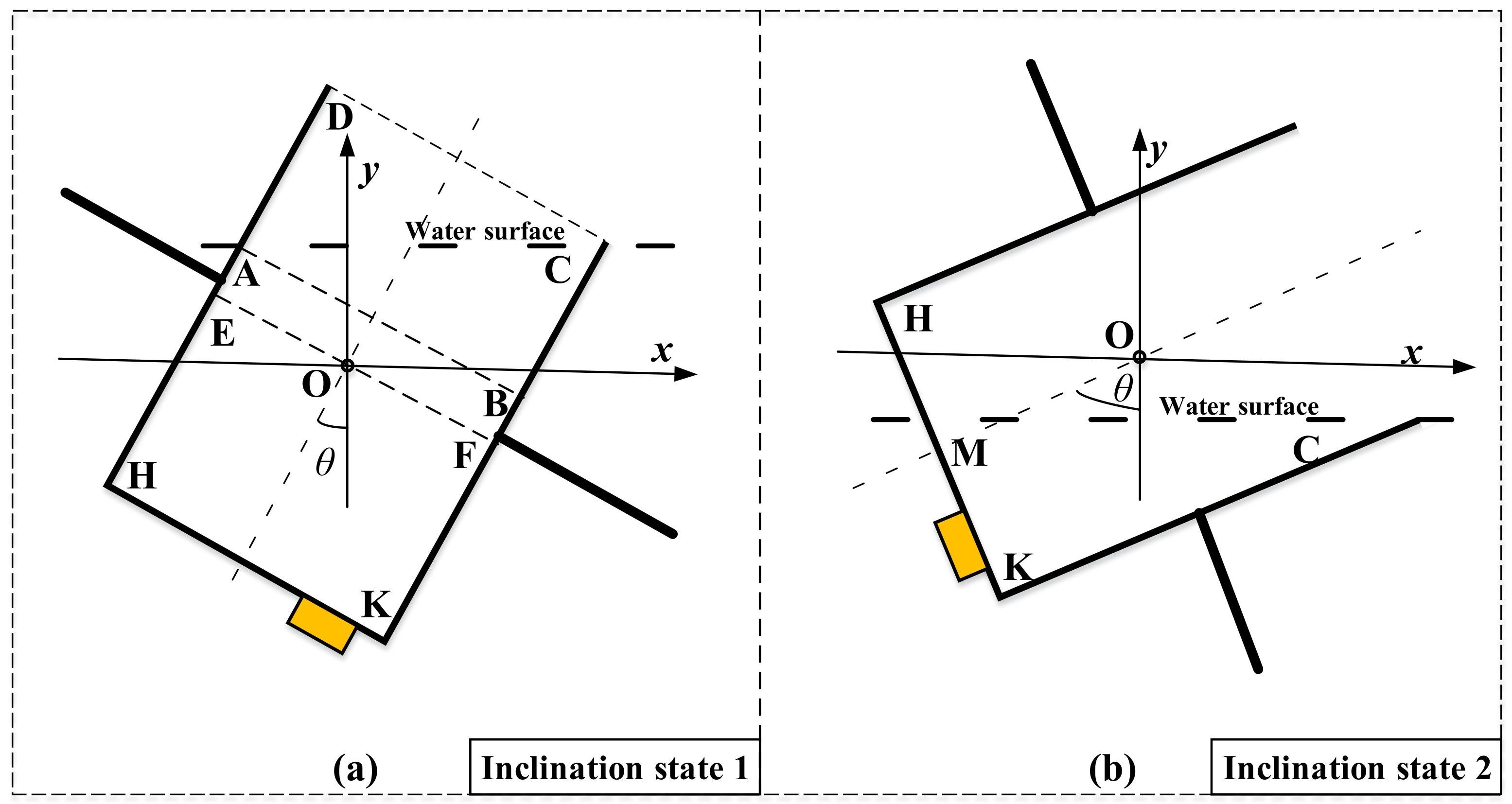
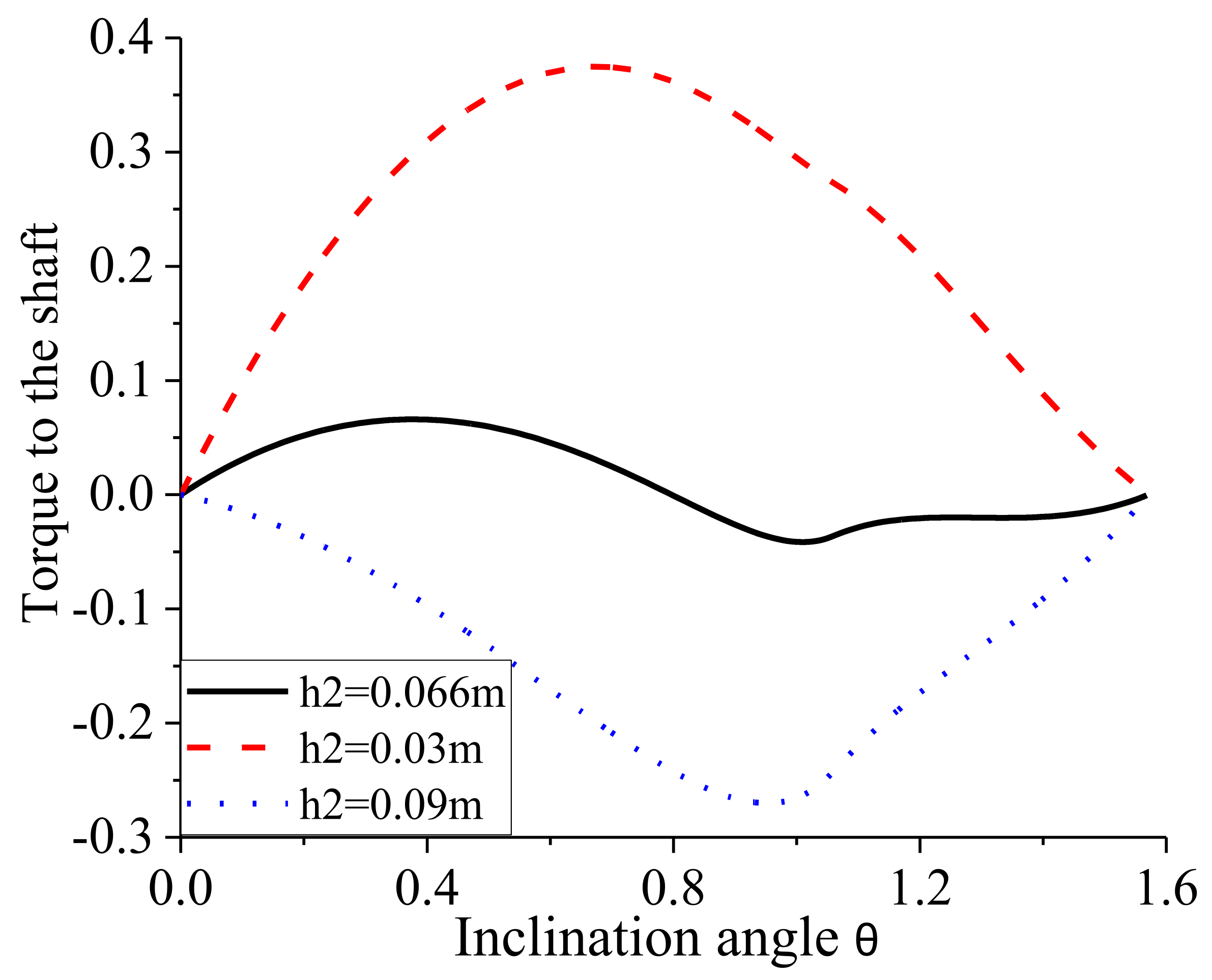

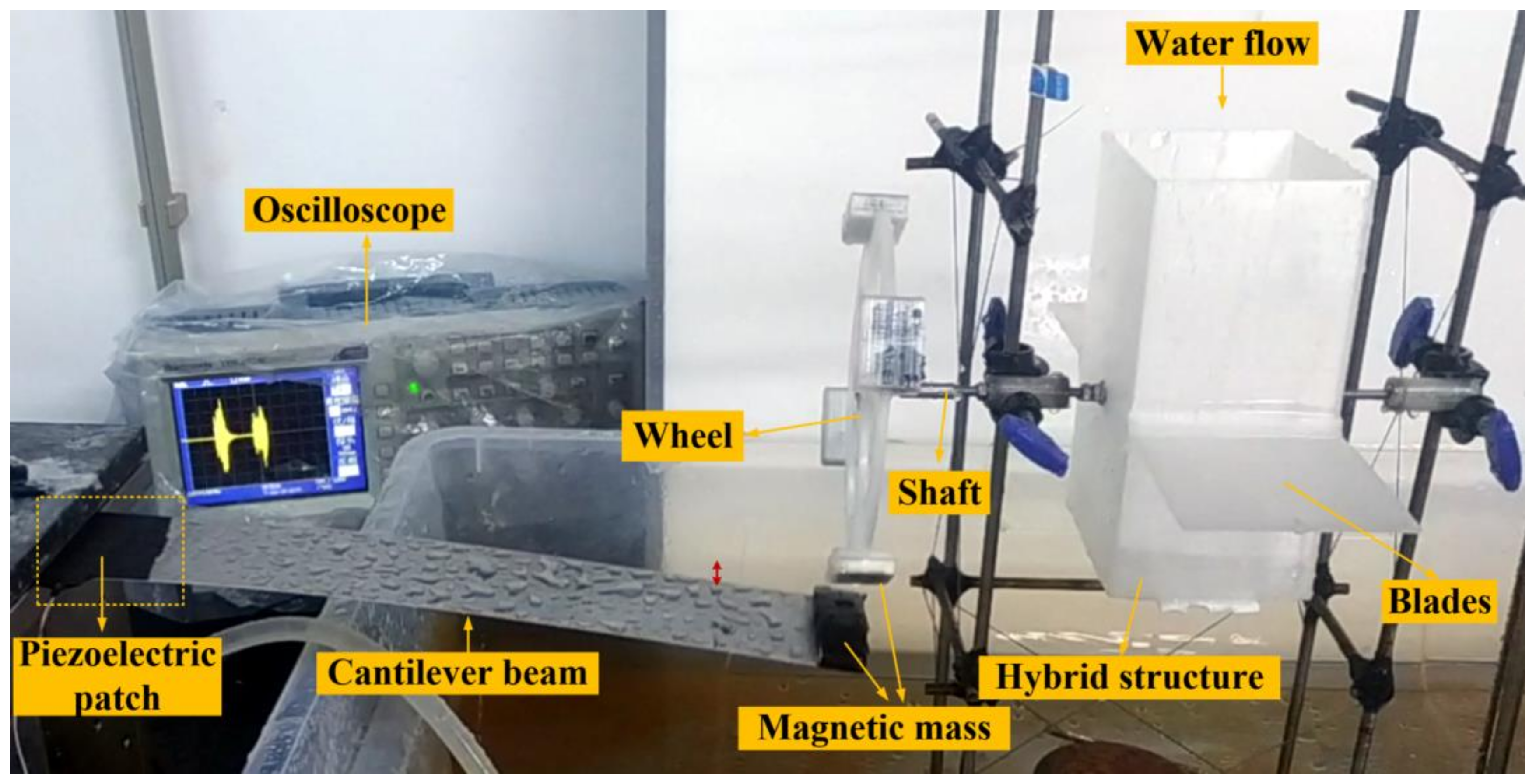

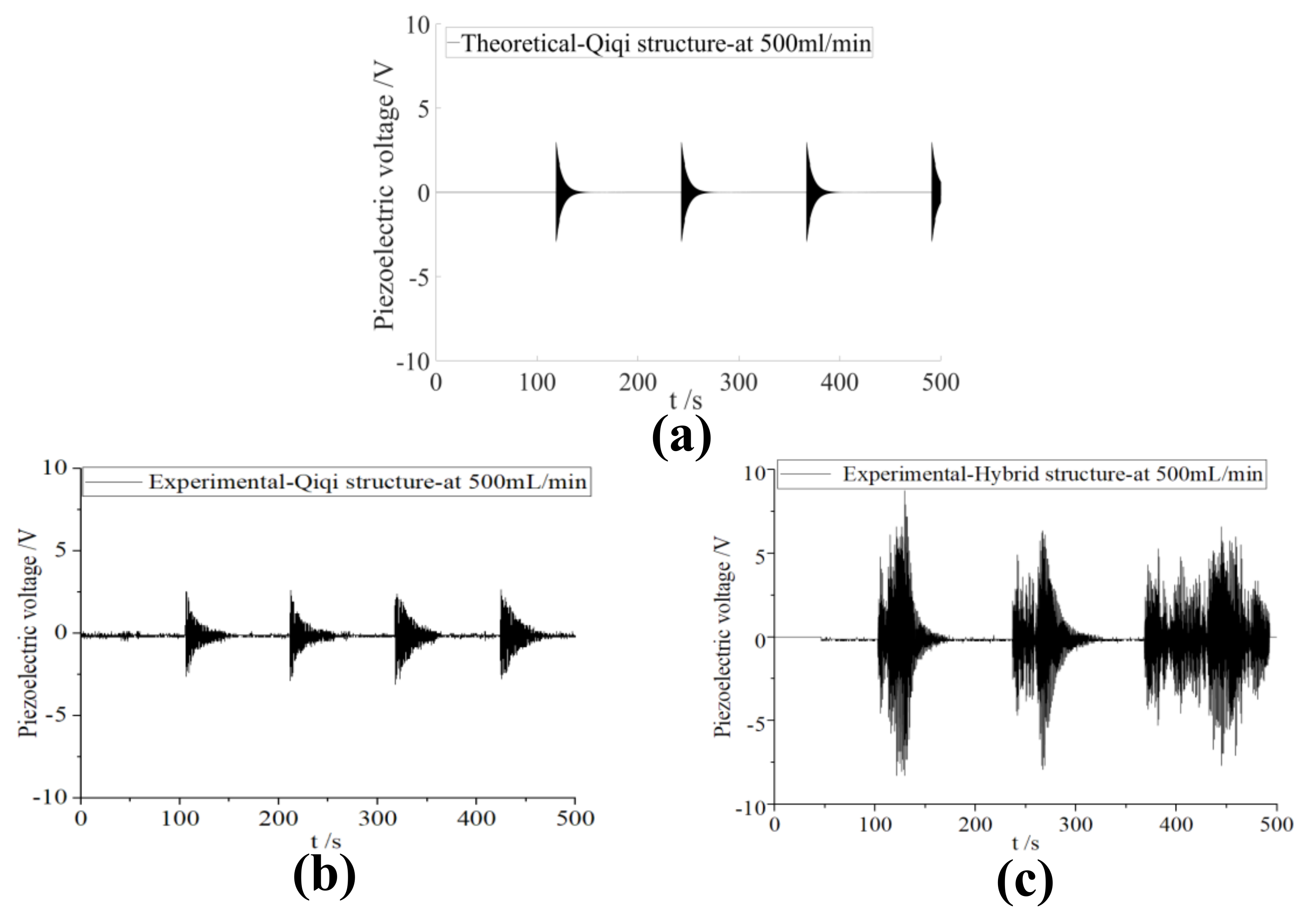
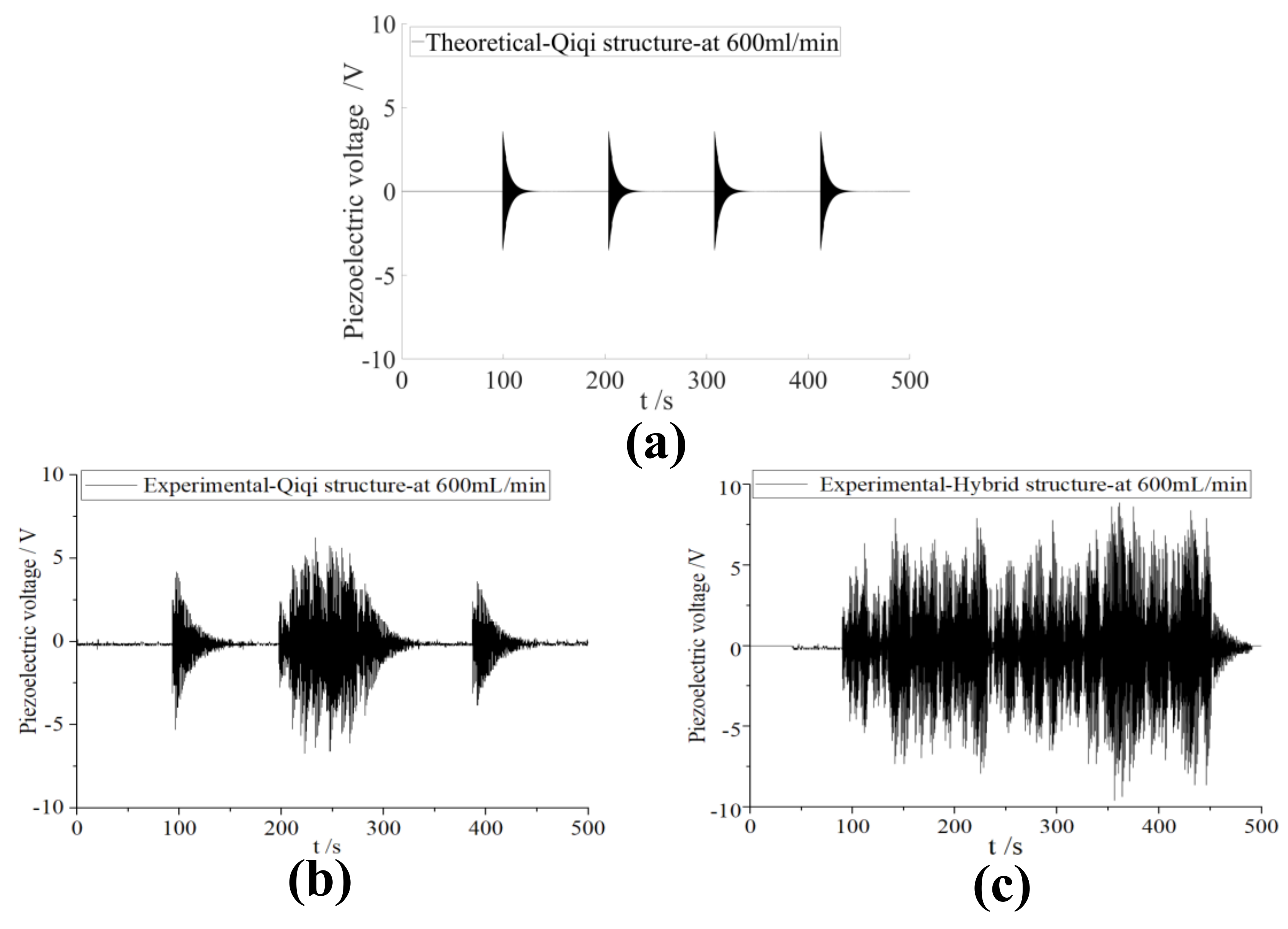


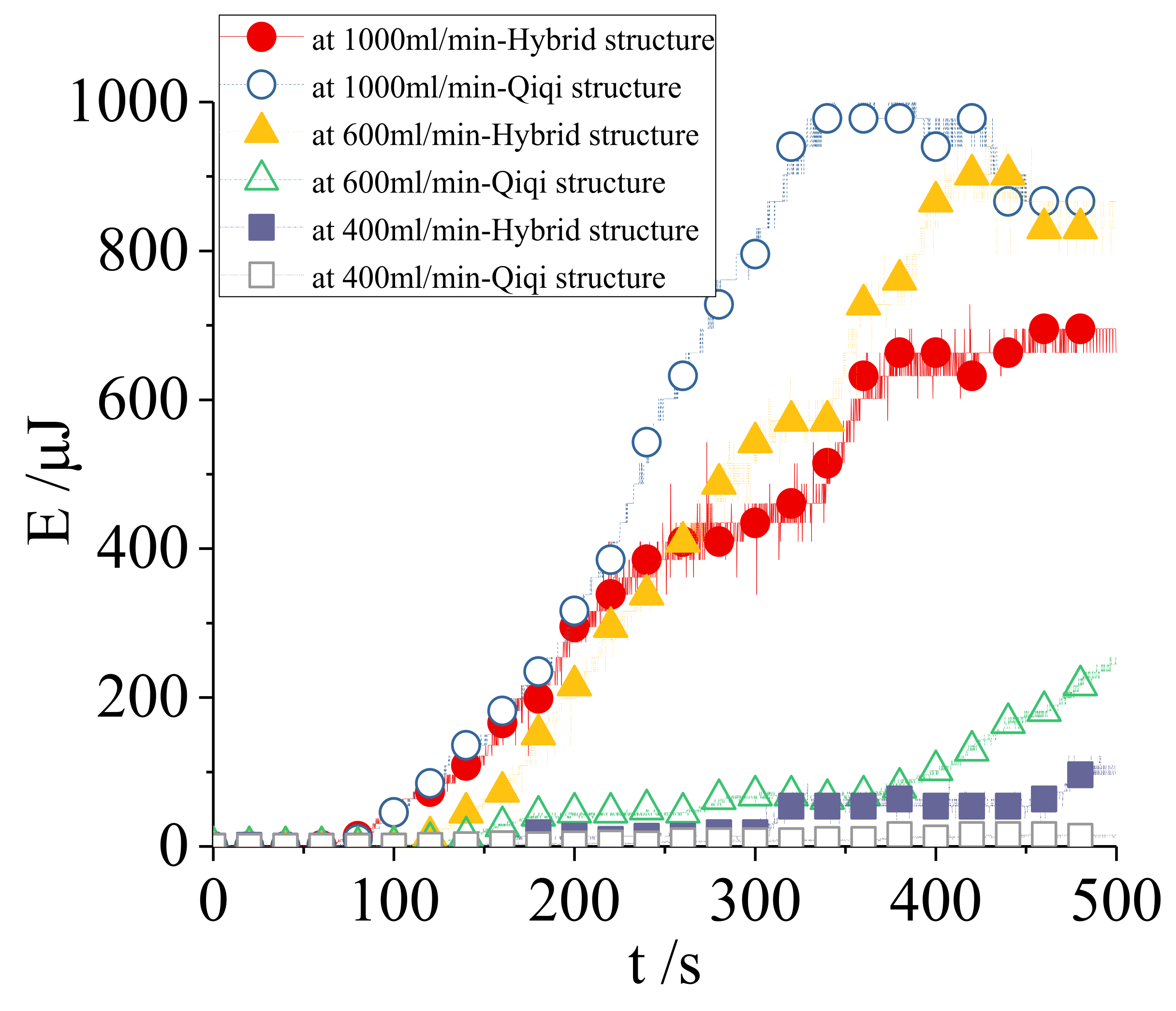
| Parameters | Annotation | Value |
|---|---|---|
| Lbl × Wbl × hbl | The size of the blade | 0.08 m × 0.075 m × 0.0015 m |
| 2 × a | the width of the Qiqi structure | 0.007 m |
| 2 × b | the length of the Qiqi structure | 0.009 m |
| h1 | The height of the Qiqi structure | 0.16 m |
| h2 | The height of the rotating shaft | 0.066 m |
| Vvol | The volume of the hybrid Qiqi structure | 990 mL |
| Parameters | Annotation | Value |
|---|---|---|
| Lb × Wb × hb | The size of the cantilever beam | 0.36 m × 0.06 m × 0.0015 m |
| ρb | The beam density | 7.93 × 103 kg/m3 |
| Eb | The beam young modulus | 19.9 × 1010 N/m2 |
| Lp × Wp × hp | The PZT size | 0.02 m × 0.06 m × 0.0007 m |
| σp | The PZT poisson’s ratio | 0.35 |
| ρb | The PZT density | 7.6 g/cm3 |
| Ep | The PZT young modulus | 6.2 × 1010 N/m2 |
| d31 | Piezoelectric charge constant | −340 PC/N |
| ε33T/ε0 | Relative electrical permittivity | 5000 |
| mmag | The mass on the beam | 360 g |
| J’,J | The magnetization of the magnets | 1.2 T |
| μ0 | Vacuum permeability | 4π × 10−7 N/A2 |
| rwl | The disk radius | 0.07 m |
| ag × bg × cg | The size of the mass on the disk | 0.02 m × 0.03 m × 0.005 m |
| Ag × Bg × Cg | The size of the mass on the beam | 0.02 m × 0.06 m × 0.01 m |
| g | Gravitational acceleration | 9.8 N/kg |
Publisher’s Note: MDPI stays neutral with regard to jurisdictional claims in published maps and institutional affiliations. |
© 2021 by the authors. Licensee MDPI, Basel, Switzerland. This article is an open access article distributed under the terms and conditions of the Creative Commons Attribution (CC BY) license (https://creativecommons.org/licenses/by/4.0/).
Share and Cite
Bao, B.; Wang, Q.; Wu, Y.; Li, P. Experimental Study on Hydroelectric Energy Harvester Based on a Hybrid Qiqi and Turbine Structure. Energies 2021, 14, 7601. https://doi.org/10.3390/en14227601
Bao B, Wang Q, Wu Y, Li P. Experimental Study on Hydroelectric Energy Harvester Based on a Hybrid Qiqi and Turbine Structure. Energies. 2021; 14(22):7601. https://doi.org/10.3390/en14227601
Chicago/Turabian StyleBao, Bin, Quan Wang, Yufei Wu, and Pengda Li. 2021. "Experimental Study on Hydroelectric Energy Harvester Based on a Hybrid Qiqi and Turbine Structure" Energies 14, no. 22: 7601. https://doi.org/10.3390/en14227601






